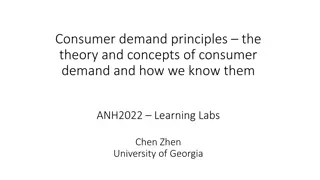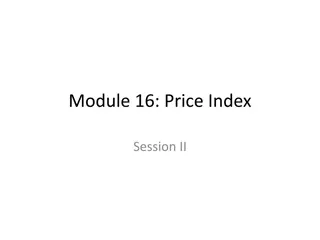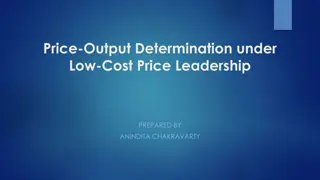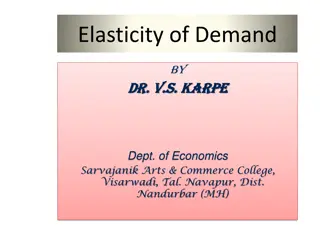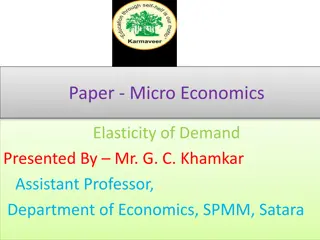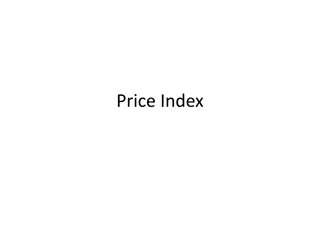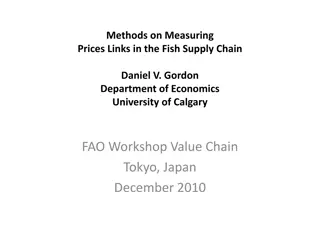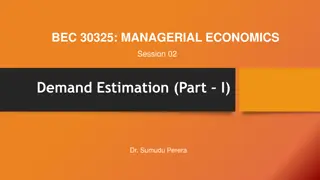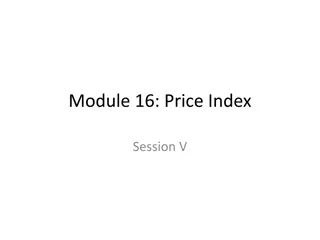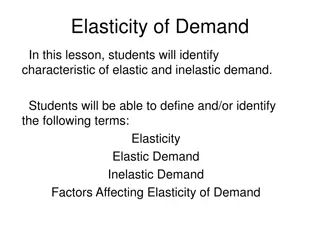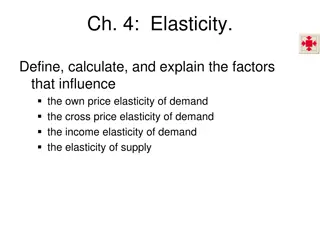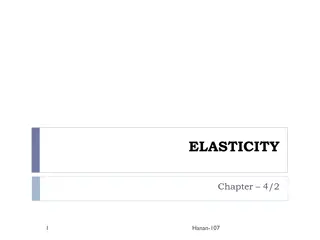Understanding Price Elasticity in Economics
Explore the key concepts of price elasticity in economics, including calculations, determinants, and applications. Understand the differences between price elasticity of demand and supply, learn how to calculate price elasticity, and interpret elasticity coefficients. Discover the responsiveness of demand and supply to price changes and the implications for economic analysis.
Download Presentation

Please find below an Image/Link to download the presentation.
The content on the website is provided AS IS for your information and personal use only. It may not be sold, licensed, or shared on other websites without obtaining consent from the author. Download presentation by click this link. If you encounter any issues during the download, it is possible that the publisher has removed the file from their server.
E N D
Presentation Transcript
Elasticity: Concepts and Applications
Acknowledgments This PowerPoint presentation is based on and includes content derived from the following OER resource: Principles of Microeconomics An OpenStax book used for this course may be downloaded for free at: https://openstax.org/details/books/principles-microeconomics-2e 2
Key Questions What is price elasticity and how is it calculated? What are the determinants of price elasticity? What are some applications of price elasticity? What are the other important types of elasticity? 3
Price Elasticity of Demand and Price Elasticity of Supply Elasticity in general is a measure of the responsiveness of one economic variable to changes in another. Price elasticity of demand - is the ratio of the percentage change in the quantity demanded (Qd) to the corresponding percentage change in price. Price elasticity of supply - is the ratio of the percentage change in the quantity supplied (Qs) to the corresponding percentage change in price. 4
Calculating Price Elasticity(1 of 2) The percentage change in quantity demanded or supplied is calculated as: % ? = ? ? The percentage change in price calculated as: % ? = ? ? The elasticity coefficient is the ratio of the two percentage changes. ?=% ? % ? 5
Calculating Price Elasticity (2 of 2) The calculation is straightforward except for how to define the base value of Q and P when calculating the percentage change in Q and P. You get a different answer by using the beginning values of Q and P than with the ending values, and the difference will be larger the greater the distance between beginning and ending values. The preferred way to avoid confusion is to use the average of the beginning and ending values of Q and P. This method is called the midpoint method. 6
Interpreting Price Elasticity If demand (or supply) is responsive to a change in price, ??> ? and we say that demand (or supply) is elastic. If demand (or supply) is not very responsive to a change in price, ??< ?and we say that demand (or supply) is inelastic. If the response is exactly proportional,??= ? and we say elasticity is unitary. 7
Getting Comfortable With Price Elasticity The elasticity coefficient is a ratio of two percentage changes and is expressed as a unitless number. Price elasticity of demand, as calculated, is always negative but, for convenience, economists often express it as a positive. The price elasticity of supply as calculated is always positive and expressed that way. Price elasticity is a ratio of percentage changes so its value changes as we move up or down a demand or supply curve. Price elasticity is not the slope of the demand or supply curve. 8
Exercise: Calculating the Price Elasticity of Demand From a Demand Curve Use the midpoint formula to calculate the price elasticity of demand between points H and G. between points B and A. Question: Is demand elastic or inelastic? 9
Answers to Price Elasticity of Demand Exercise Between points H and G: % Q = (1800-1600)/(1600+1800)/2 = 200/1700 = 11.7% % P = (120-130)/(130+120)/2 =-10/125 = -8% Between points B and A: ED = 11.7% / -8% = -1.5 Elastic % Q = (3000-2800)/(2800+3000)/2 = 200/2900 = 6.9% % P = (60-70)/(70+60)/2 =-10/65 = -15.4% ED = 6.9% / -15.4% = -0.45 Inelastic 10
Exercise: Calculating the Price Elasticity of Supply From a Supply Curve Use the midpoint formula to calculate the price elasticity of supply between points A and B. Question: Is supply elastic or inelastic with respect to price? 11
Answer to Price Elasticity of Supply Exercise Between points A and B: % Q = (13000-10000)/(10000+13000)/2 = 3000/11500 = 26.1% % P = (700-650)/(650+700)/2 = 50/675 = 7.4% ES = 26.1% / 7.4% = 3.5 Elastic 12
Infinite Elasticity One extreme case is infinite elasticity which means that the quantity demanded or supplied changes by an infinite amount in response to any change in price. In either case, the curve is horizontal. An example of infinite demand elasticity is the individual firm s demand curve in a competitive market: 13
Zero Elasticity A second extreme case is zero elasticity, which means that the quantity demanded or supplied does not change at all, regardless of the change in price. In either case, the curve is horizontal. An example of zero demand elasticity is the demand for a life-saving drug. 14
Constant Unitary Elasticity Constant unitary elasticity, for demand or supply, occurs when a given % change in price results in the same % change in quantity demanded or supplied. The coefficient for unitary elasticity is 1. As shown, a demand curve with constant unitary elasticity will be a curved line. A supply curve with constant unitary elasticity will be a straight line from the origin. 15
What are the Determinants of Price Elasticity of Demand? The primary determinant is the availability of substitutes. The more substitutes for a good, the greater the price elasticity of that good. The importance of the good in the household budget. If the good constitutes a big part of the budget, its demand is more price elastic. How broadly the market for the good is defined. The elasticity for a specific brand of mustard is higher than the elasticity of demand for mustard as a category. The time horizon being considered. The longer the time horizon, the greater the price elasticity (see next slide). 16
Price and Quantity Response to Supply Change in the Short vs. Long Run Start at E0 on both panels and consider impact of a leftward shift in supply of oil from S0 to S1. Panel (a) shows the impact on P and Q of oil in the short run given inelastic short-run demand. Panel (b) shows the impact on P and Q oil in the long run given elastic long-run demand. 17
What are the Determinants of Price Elasticity of Supply? The flexibility of producers in ramping up or ramping down production of goods and services. Greater flexibility means more responsiveness and therefore, higher elasticity of supply. Flexibility is a function of production capacity and the ability to store goods. The time horizon being considered. During the immediate horizon, elasticity tends to be lower. 18
Applications of Price Elasticity Here are three applications of price elasticity. Assessing the price/quantity response of a change in supply. The incidence of taxation. The relationship between elasticity and total revenue. 19
Elasticity and Price Change (1 of 3) Increases in business costs shift the supply curve to the right and decreases shift it to the left. The impact of the change in costs on market equilibrium, however, depends on the relative elasticities of the market demand and market supply curves. 20
Elasticity and Price Change (2 of 3) A rise in production costs shifts supply to the left from S0 to S1 meaning that firms are now willing to supply only a lesser quantity at any price. Panel (a): If demand is inelastic, the result of cost increase will be a much higher price but only a small decrease in quantity. Panel (b): If demand is elastic, the result will be only slightly higher prices but a large decrease in quantity. 21
Elasticity and Price Change (3 of 3) A fall in production costs shifts supply to the right from S0 to S1 meaning that firms will be willing to supply a greater quantity at any price. Panel (a): If demand is inelastic, the result of fall in cost will be a much lower price but a small increase in quantity. Panel (b): If demand is elastic, the result will be only slightly lower prices but a large increase in quantity. 22
Elasticity and Tax Incidence (1 of 2) Tax incidence refers to the manner in which the tax burden is divided between buyers and sellers. The incidence of a tax depends on the relative elasticities of the demand and supply curves. If demand is more inelastic than supply, buyers bear most of the tax incidence. If supply is more inelastic than demand, sellers bear most of the tax incidence. 23
Elasticity and Tax Incidence (2 of 2) An excise tax creates a gap between the price paid by consumers (Pc) and the price received by producers (Pp). Panel (a): Demand is more elastic than supply so the tax incidence on consumers, Pc Pe, is less than on producers, Pe Pp. Panel (b): Supply is more elastic than demand so the tax incidence on consumers, Pc Pe, is larger than on producers, Pe Pp. 24
Elasticity and Total Revenue (1 of 2) For a firm facing a downward-sloping demand curve, price elasticity is key to understanding the change in the firm s total revenue due to a change in price. ????? ??????? = ????? ???????? We know the direction of change in quantity demanded due to a change in price. The law of demand tells us that a firm can sell more only if it lowers its price. Elasticity tells us about the responsiveness of that change. 25
Elasticity and Total Revenue (2 of 2) The effect of a price change on total revenue depends on the elasticity of demand. If demand is elastic, ?> 1, a 1% decrease in price will increase quantity demanded by more than 1%, leading to an increase in total revenue. If demand is inelastic, ?< 1, a 1% decrease in price will increase quantity demanded by less than 1%, leading to a decrease in total revenue. If demand is unitary elastic, ?= 1, a 1% decrease in price of 1% will increase quantity demanded by exactly 1%, resulting in no change in total revenue. 26
Income Elasticity (1 of 2) Income elasticity of demand the response of demand to a change in income. ??=% ?????? % ?????? For most goods, income elasticity of demand is positive meaning that a rise in income will cause an increase in demand (a rightward shift in the demand curve). 27
Income Elasticity (2 of 2) If ?> 0, the good is a normal good meaning that an increase in income would lead the consumer to buy more of the good. Most goods are normal goods although some are more responsive to income growth. If ?< 0, the good is an inferior good meaning that an increase in income would lead consumers to buy less of the good. Traditional examples are goods like canned beans or ramen noodles or renting a room in a boarding house. 28
Cross Price Elasticity (1 of 2) Cross price elasticity of demand the response of the demand of one good to a change in the price of another good. ??=% ?????? ??? ???? ? % ????? ?? ???? ? The relationship between the change in demand for one good and the change in price of another good can take on positive or negative values. 29
Cross Price Elasticity (2 of 2) If ?> 0, the goods are substitutes. That means that an increase in the price of good A would increase the demand for good B as consumers substituted good B for good A. An example of substitute goods is chicken and pork. If ?< 0, the goods are complements. That means that an increase in the price of good A would decrease the demand for good B as consumers bought less of both. An example of complementary goods is laptops and software. 30
Other Elasticity Coefficients Wage elasticity of labor supply (labor demand) measures the response of labor supply (labor demand) to changes in the wage level. Interest rate elasticity of saving (borrowing) measures the response of saving (borrowing) to changes in the interest rate. Question: what would you expect the signs of these elasticity coefficients to be? 31



